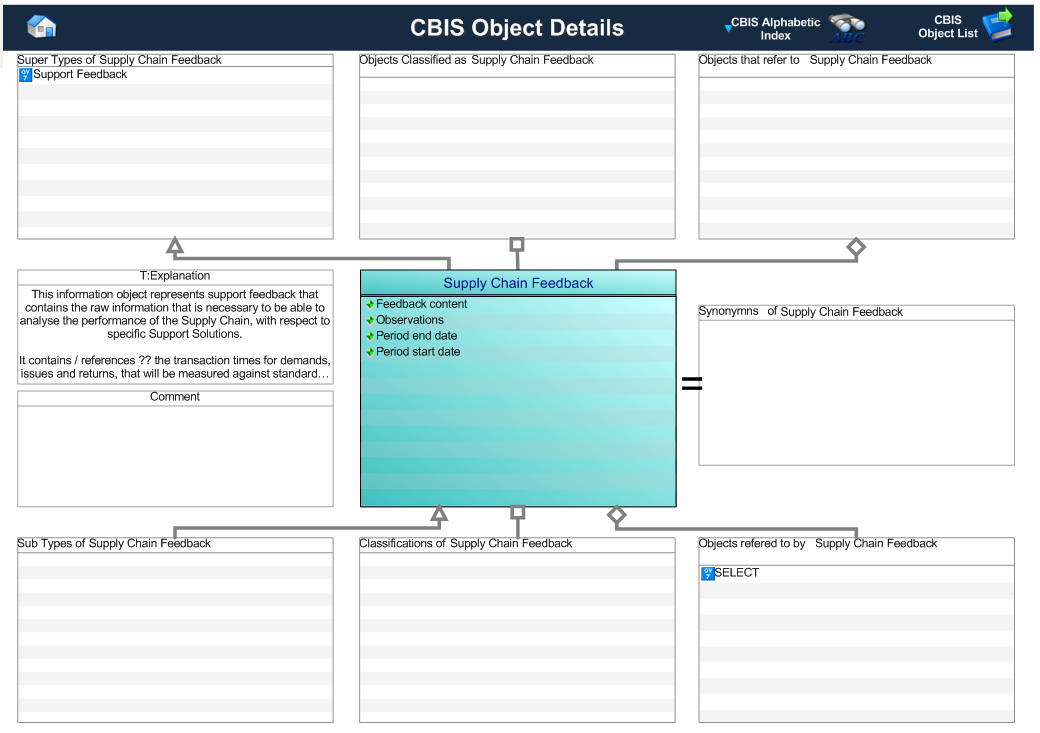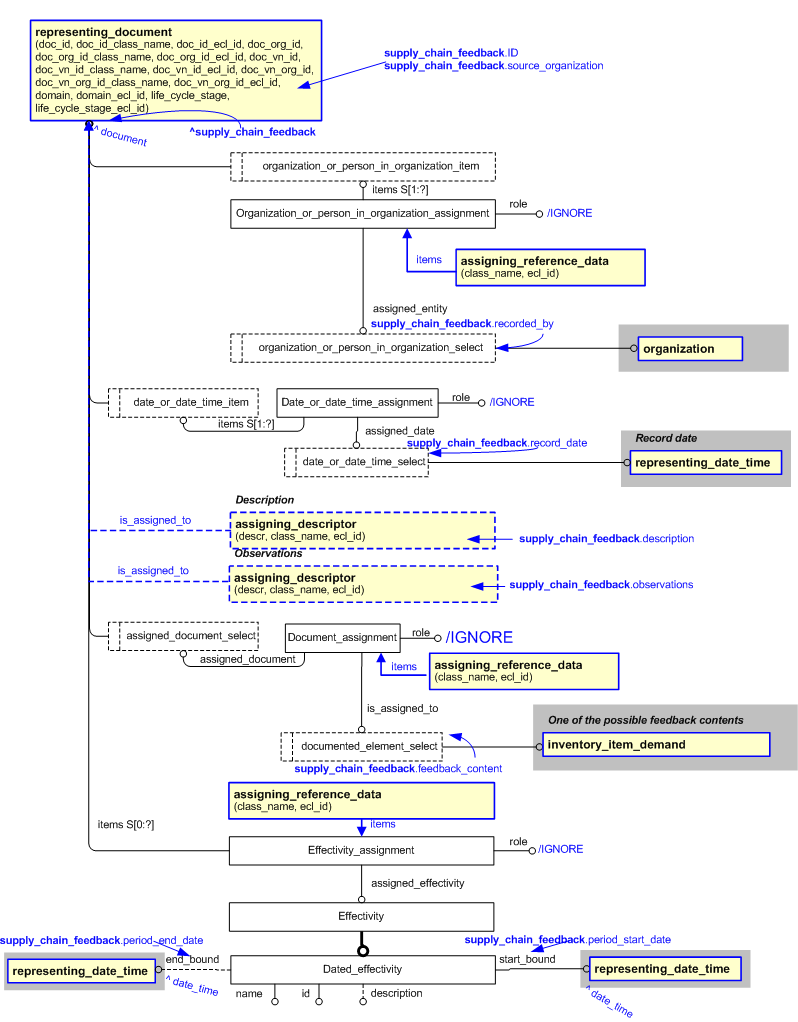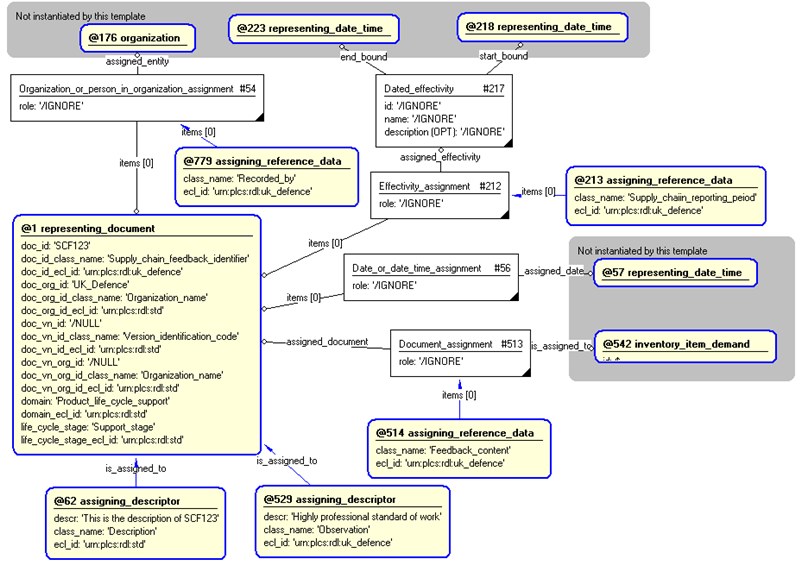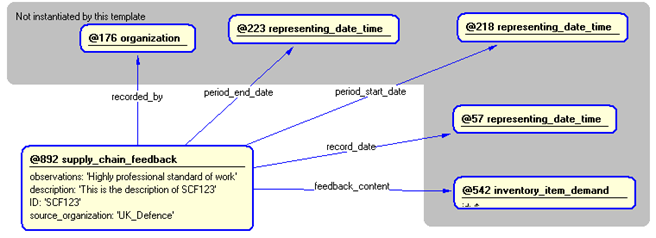Template:— supply_chain_feedback (sup_chn_fbk)
Context:— UK_Defence |
Date: 2009/04/17 11:50:21
Revision: 1.3
|
This section specifies the template supply_chain_feedback.
NOTE
The template has been defined in the context of
UK_Defence.
Refer to the business context for details of related templates.
NOTE
An explanation of a template and the associated instantiation path is
provided in the
Template overview
section.
This template describes how to represent the support feedback that contains the raw information that is necessary
to be able to analyse the performance of the Supply Chain, with respect to specific Support Solutions.
It contains / references the transaction times for demands, issues and returns, that will be measured against standard
pipeline times, during analysis.
This information object represents an analysis that has been performed on support feedback for the purposes of determining
whether specific performance metrics have been met.
The results of each Performance Analysis are recorded by means of relationships from the information objects that
are generated by the
analysis and the Performance Analysis object itself.
Figure 1 — Graphical Representation for Business Object Supply Chain Feedback
Supply Chain Feedback:
|
Attribute name
|
Attribute description
|
Attribute type
|
Optionality
|
| Feedback content |
The people and/or organizations that conducted the support analysis. |
Relationship to SELECT object(s); Inventory Item Demand (LCIA Information Element),
Inventory Item Issue (LCIA Information Element),
Inventory Item Return (LCIA Information Element),
Inventory Item Receipt (LCIA Information Element)
Discrepancy Report (LCIA Information Element),
Dues In (LCIA Information Element),
Inventory Item Demand Response(LCIA Information Element)
|
Mandatory (1:?) |
| Observations |
This is the set of qualitative observations that have been made about the
supply chain by the person recording the feedback.
It may include judgements of successes, shortfalls and / or recommendations for improvement.
|
intrinsic |
Optional |
| Period end date |
This is the end date of the period for which the feedback is reported. |
intrinsic |
Mandatory |
| Period start date |
This is the start date of the period for which the feedback is reported. |
intrinsic |
Mandatory |
Table 1 — Supply Chain Feedback attribute details:
The EXPRESS-G diagram in
Figure
2
shows the templates and EXPRESS entities that are required
to represent the template
"supply_chain_feedback".
The text highlighted in blue shows the template parameters.
Figure 2 — An EXPRESS-G representation of the Information model for supply_chain_feedback
The graphic for the template to be used in other EXPRESS-G diagrams
is shown in Figure
3
below.
Figure 3 — The graphical representation of the supply_chain_feedback template
The following input parameters are defined for this template:
The people and/or organizations that conducted the support analysis.
This is the set of qualitative observations that have been made about the
supply chain by the person recording the feedback.
It may include judgements of successes, shortfalls and / or recommendations for improvement.
This is the end date of the period for which the feedback is reported.
This is the start date of the period for which the feedback is reported.
This is the description of the Supply Chain Feedback.
This is the identifier of the Supply Chain Feedback.
The organization that created the identifier. Additionally
a Person or Information System could be defined when either of these are the source; see Identifier template.
This is the start date of the period for which the feedback is reported.
This is the reference to the person or system which recorded the feedback
The following reference parameters are defined for this template:
Allow the
Document
entity instantiated in this path to be referenced when this template is used.
Note: The
Document
entity can be referenced in a template path by:
%^target = $supply_chain_feedback.supply_chain_feedback%
where
target
is the parameter to which the
Document
is bound.
The following parameter combinations specify a uniqueness constraint:
Unique constraint: Supply_chain_feedback
Each instance of the
entity
(
Document)
within the data set shall be uniquely identified
by the following parameters on this
template (supply_chain_feedback) namely:
ID.
The
instance is
referenced by the following template parameter:
supply_chain_feedback.
The instantiation path shown below specifies the entities that are to be
instantiated by the template.
A description of templates and the syntax for the instantiation path is
provided in the
Templates Help/Information section.
-- Representing document /
representing_document(
doc_id=@ID,
doc_id_class_name='Supply_chain_feedback_identifier',
doc_id_ecl_id='urn:plcs:rdl:uk_defence',
doc_org_id=@source_organization,
doc_org_id_class_name='Organization_name',
doc_org_id_ecl_id='urn:plcs:rdl:std',
doc_vn_id=/NULL,
doc_vn_id_class_name='Version_identification_code',
doc_vn_id_ecl_id='urn:plcs:rdl:std',
doc_vn_org_id='/NULL',
doc_vn_org_id_class_name='Organization_name',
doc_vn_org_id_ecl_id='urn:plcs:rdl:std',
domain='Product_life_cycle_support',
domain_ecl_id='urn:plcs:rdl:std',
life_cycle_stage='Support_stage',
life_cycle_stage_ecl_id='urn:plcs:rdl:std')/
%^supply_chain_feedback = $representing_document.document%
-- Create relationship to recorded_by Organization_or_person_in_organization_assignmentOrganization_or_person_in_organization_assignment.items ->
^supply_chain_feedback
Organization_or_person_in_organization_assignment.assigned_entity ->
@recorded_byOrganization_or_person_in_organization_assignment.role = '/IGNORE'
%^rec_by =
Organization_or_person_in_organization_assignment%
/
assigning_reference_data(
class_name='Recorded_by',
ecl_id='urn:plcs:rdl:uk_defence',
items=^rec_by)/
-- Record date Date_or_date_time_assignmentDate_or_date_time_assignment.role = '/IGNORE'
Date_or_date_time_assignment.items ->
^supply_chain_feedback
Date_or_date_time_assignment.assigned_date ->
@record_date-- [optional Description] /
assigning_descriptor(
descr=@description,
class_name='Description',
ecl_id='urn:plcs:rdl:uk_defence',
is_assigned_to=^supply_chain_feedback)/
-- [optional Observation] /
assigning_descriptor(
descr=@observations,
class_name='Observation',
ecl_id='urn:plcs:rdl:uk_defence',
is_assigned_to=^supply_chain_feedback)/
-- Related feedback_content Document_assignmentDocument_assignment.role = '/IGNORE'
Document_assignment.assigned_document ->
^supply_chain_feedback
Document_assignment.is_assigned_to ->
@feedback_content%^feedback_cont =
Document_assignment%
/
assigning_reference_data(
class_name='Feedback_content',
ecl_id='urn:plcs:rdl:uk_defence',
items=^feedback_cont)/
-- Reporting Period Dated_effectivityDated_effectivity.id = '/IGNORE'
Dated_effectivity.name = '/IGNORE'
Dated_effectivity.description = '/IGNORE'
Dated_effectivity.start_bound ->
@period_start_dateDated_effectivity.end_bound ->
@period_end_date%^dated_effectivity =
Dated_effectivity%
Effectivity_assignmentEffectivity_assignment.role = '/IGNORE'
Effectivity_assignment.items ->
^supply_chain_feedback
Effectivity_assignment.assigned_effectivity ->
^dated_effectivity
%^effectivity_assignment =
Effectivity_assignment%
/
assigning_reference_data(
class_name='Supply_chain_reporting_period',
ecl_id='urn:plcs:rdl:uk_defence',
items=^effectivity_assignment)/
The following entities are instantiated with attributes as specified:
The instance diagram in Figure
4
shows an example of the EXPRESS entities and templates that are instantiated by the template:
/supply_chain_feedback(feedback_content='@542', observations='Highly professional standard of work', period_end_date='@223', period_start_date='@218', description='This is the description of SCF123', ID='SCF123', source_organization='UK_Defence', record_date='@57', recorded_by='@176')/
(an illustration of the consolidated supply_chain_feedback template is shown in
Figure
5 below.)
Figure 4 — Entities instantiated by supply_chain_feedback template
The instance diagram in
Figure
5
shows the graphic symbol for the template that is to be
used in other instance diagrams. The example template is:
/supply_chain_feedback(feedback_content='@542', observations='Highly professional standard of work', period_end_date='@223', period_start_date='@218', description='This is the description of SCF123', ID='SCF123', source_organization='UK_Defence', record_date='@57', recorded_by='@176')/
Figure 5 — Instantiation of supply_chain_feedback template
Characterizations
No common characterizations of the template
supply_chain_feedback
have been identified. However, the ISO 10303-239 EXPRESS model
may enable other assignments to the entities instantiated by the template.




